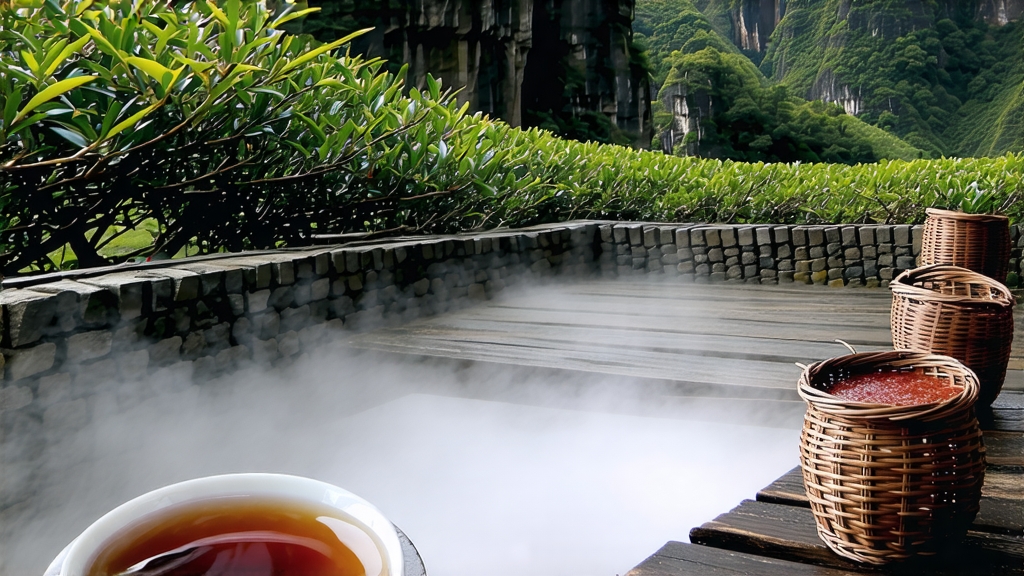
High above the winding Jiuqu Stream, where the Wuyi Mountains thrust their granite shoulders into the humid Fujian sky, grows the most mythic of all oolongs—Da Hong Pao, literally “Big Red Robe.” To understand this tea is to step into a tapestry woven from imperial edicts, scholarly poems, Buddhist chants, and the quiet footfalls of generations of tea makers who still climb narrow plank paths bolted to vertical rock faces to tend their treasured mother trees. In the West, Da Hong Pao is often reduced to a romantic name on a café menu; in China, it is a cultural relic, a liquid manuscript whose every infusion whispers dynastic secrets.
The origin story most frequently repeated in the mountain villages tells of a Ming-dynasty scholar on his way to the capital examinations. Stricken with fever, he was revived by a brew made from the leaves of four stunted bushes clinging to a cleft in Tianxin Cliff. Upon earning the highest academic honor, he returned in gratitude, draping his imperial-red robe over the bushes to protect them from the cold—hence the name. Whether apocryphal or not, the tale is etched into local memory, and those six original mother trees, now venerated for over 350 years, still stand, their gnarled trunks wrapped in red silk during spring festivals. Since 2006, the Chinese government has forbidden commercial harvesting of the mother trees; the last 20 grams plucked in 2005 fetched 208,000 yuan at auction, a testament to the tea’s totemic status.
Yet Da Hong Pao is not a single, static cultivar; it is a constellation of genetic and artisanal possibilities. Broadly, the market recognizes three categories. “Mother-tree Da Hong Pao” exists only as frozen archival leaf and museum relics. “Purebred Da Hong Pao” comes from asexually propagated cuttings of the mother trees—Qi Dan and Bei Dou No. 1 being the most prestigious clones—cultivated in the same microterroir of the Wuyi scenic reserve. Finally, “blended Da Hong Pao,” which accounts for 95 % of what circulates globally, is an orchestral composition of three to five Wuyi cultivars—Rou Gui for spice, Shui Xian for orchid depth, Tie Luo Han for mineral backbone—harmonized by a master blender to echo the aromatic silhouette of the legendary original. This blending tradition, far from being adulteration, is a respected craft analogous to the assemblage of Champagne.
The concept of “rock rhyme” (yanyun) is the elusive holy grail that separates authentic Wuyi rock oolong from teas grown merely nearby. It is a sensory triad: a metallic tingling on the sides of the tongue like licking a battery, a cooling camphor finish that creeps up the throat, and a lingering sweetness that reappears minutes after swallowing, as if the cliffs themselves have dissolved into the liquor. Geologists attribute this to the tuffaceous volcanic substrate that fractures into shallow, mineral-rich soils, forcing roots to struggle and concentrate aromatic polyphenols. Tea makers speak in more poetic terms: “The rocks breathe, and the tea remembers.”
Harvest begins in late April when the azaleas on the slopes blush pink. Only the middle three leaves and the bud are plucked between 9 a.m. and noon, while the mountain mist still shields them from direct sun. The leaves are carried in bamboo baskets so shallow that no leaf is crushed, then withered on bamboo racks in a shaded corridor where mountain breeze alternates with wafts of woodsmoke from distant farmhouses. Oxidation is neither fully green nor fully black, but a carefully choreographed 30–50 % journey. The master monitors the transformation by touch: when the leaf edge turns chestnut brown and the center remains jade, it is time for the most dramatic step—shaqing, or “killing the green.” In Wuyi, this is done in a wok heated to 240 °C by burning local pine logs. The tea maker tosses 4–5 kilograms of leaves with a rhythmic swoosh that sounds like ocean surf, bare forearms enduring temperatures that would blister novices.
What follows is the craft that gives Da Hong Pao its soul: charcoal roasting. The partially dried leaves are loaded into 60-centimeter-wide bamboo baskets suspended over a pit of glowing embers. The fire must